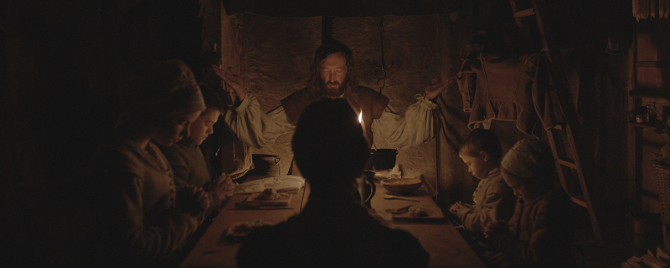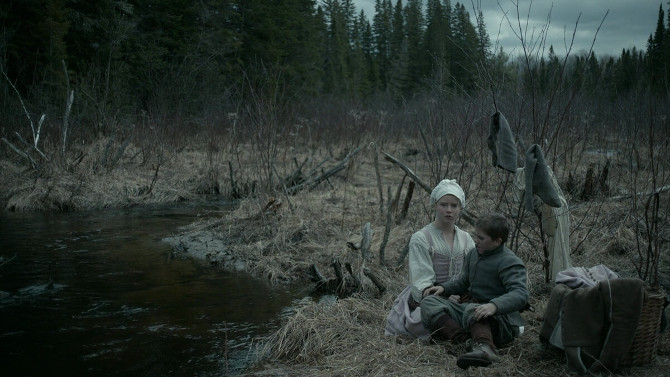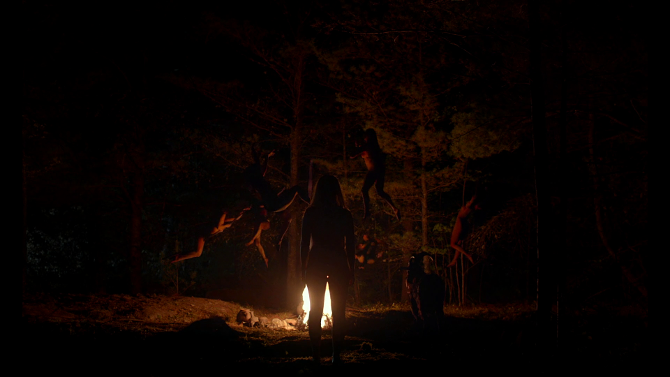“Double, double toil and trouble; Fire burn and caldron bubble. . .” – witches, constant fodder for horror films, but one feature that takes a more sophisticated look at the boiled, pointed black hat wearing creatures, is first time writer/director Robert Eggers’ 2015 motion picture The VVitch: A New-England Folktale – remind me never to book a vacation to rural New England.
Set in seventeenth century America, a puritanical Calvinist family has been banished from the plantation they once called home (due to religious differences). . . heading out into the wild unknown (a beautiful voyeuristic shot depicts the children leaving the bustle of the growing town), they look for some solace on their new plot of land, an open piece of property surrounded by a dark, brooding forest. More of a mood piece than a horror film. . . Eggers painstakingly recreates what life would be like in the lonesome location – the senses coming alive; you can feel the roughness of the carriage ride, see the sullen seclusion and ominously dark home life, smell the animals in the nearby barn, endure the weight of their clothing, suffer the same starvation they struggle with as their crops are destroyed by rot.
Seen through the expressive eyes of blossoming Thomasin (Anya Taylor-Joy), she is the eldest child of William (Ralph Ineson) and Katherine (Kate Dickie), the black sheep of the family when compared to Caleb (Harvey Scrimshaw), twins Mercy (Ellie Grainger) and Jonas (Lucas Dawson), and baby Samuel (Axtun Henry Dube and Athan Conrad Dube).
With a thick, shadowy atmosphere, it is clear that something foul is afoot. The crops are dying, and, at this pace, they will not have enough food to survive the looming winter months. Then, real tragedy strikes. . . as Thomasin is playing peekaboo with Samuel, he mysteriously disappears.
Convincing themselves that it was a random wolf attack, it is the second event that has caused a crack in their collective psyche – following their forced move from civilization into seclusion. Much like a familial drama, each member slowly turns on the other; Katherine traumatized, blames her eldest daughter for losing the baby, while William turns inward, secrets kept (as he has sold his wife’s heirloom silver cup) in order to purchase traps to hunt the supposed wolf that stole their youngest. The mischievous twins, never working, always playing, tinker and prod as Thomasin bears the brunt of the chores, teasing her until she threatens them by skewing the witch game they constantly play (making it sound like she is, in fact, a sorceress). Caleb is, perhaps, the least flawed, looking to help for the good of the family. . . but, even he is struggling with their puritanical outlook – stranded in the grand wilderness with no other people in sight, the youth starts to take wayward glances at his teenaged sister.
Other strange occurrences crop up – there is a mysterious hare with piercing yellow eyes that always seems to be around, while an ominous black goat makes a sudden appearance – the family capturing it and placing it in along with their pure white livestock. Also, there is a certain rustling sound that is heard often, a creepy slithering, bringing to mind a dangerous creature or witch’s cloak. Then, there is the forest, dark, inhospitable and wild, it is a reminder of the battle nature is still winning in these New World colonies.
A tale of good versus evil, it speaks to the intrusive nature of darkness. . . finding its way into peoples’ lives, in this case, slowly eating away at the unity of the devout family. With some early shots of sunny skies, the film progressively gets darker, the light seeping out of their lives as they turn on Thomasin and each other. The minimalist score, written by Mark Korven, fuses unusual instruments and eerie voices to develop a dissonant, off-putting composition that gets to the root of the folktale.
Painstakingly building history one step at a time, Eggers recruited top tradesmen and other specialists to shape this world – the buildings, clothing, fences, and dialogue all eerily accurate to the time – the low lit cinematography by Jarin Blaschke dousing their life in a gloomy, depressive, shadowy state (almost entirely done with available or natural light). As to the screenplay, most of the dialogue comes from stories or writings from the time – symbolic choices, such as the hare, speak to the animal having been perceived as being magical in the 1600s (either associated with or considered to be witches). The narrative also brings up religious notions on Calvinism, predestination, and other such concepts, ideas that would have been widely discussed and practised at the time.
Intriguingly, The VVitches can be perceived in two ways – the more horror driven way, while others can look to hints where an argument could be formed that there are actually no supernatural forces. Inspired by many different folk and fairytales (subtle references to Hansel and Gretel and Little Red Riding Hood), it speaks to the pre-Salem witch trial fears of such creatures – building upon some of the earliest myths found in the New World (a most North American rooted story). Lastly, it is once again important to impress upon you that though this is a horror film, it is more of an atmospheric, spook filled drama – never turning into an all-out scarefest that many may expect, instead, building a mesmerizing mood and aura that finds its way into the bloodstream much like the evil that slowly divides and conquers the family. Something wicked this way comes – discover seventeenth century America (witch-style), but remember to see the forest for the trees.




